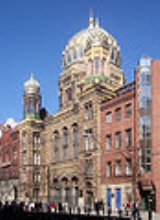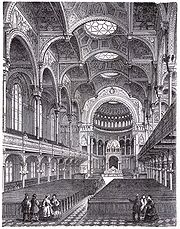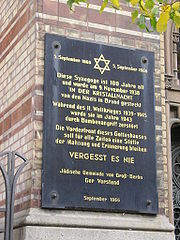
New Synagogue
Encyclopedia



Synagogue
A synagogue is a Jewish house of prayer. This use of the Greek term synagogue originates in the Septuagint where it sometimes translates the Hebrew word for assembly, kahal...
of the Berlin
Berlin
Berlin is the capital city of Germany and is one of the 16 states of Germany. With a population of 3.45 million people, Berlin is Germany's largest city. It is the second most populous city proper and the seventh most populous urban area in the European Union...
Jewish community
History of the Jews in Germany
The presence of Jews in Germany has been established since the early 4th century. The community prospered under Charlemagne, but suffered during the Crusades...
, on Oranienburger Straße. Because of its splendid eastern Moorish
Moorish architecture
Moorish architecture is the western term used to describe the articulated Berber-Islamic architecture of North Africa and Al-Andalus.-Characteristic elements:...
style and resemblance to the Alhambra
Alhambra
The Alhambra , the complete form of which was Calat Alhambra , is a palace and fortress complex located in the Granada, Andalusia, Spain...
, it is an important architectural monument of the second half of the 19th century in Berlin.
The building was designed by Eduard Knoblauch
Eduard Knoblauch
Eduard Knoblauch was a German architect.Eduard Knoblauch was born in his family's house on Poststraße 23 in the Nikolaiviertel neighborhood in Berlin, Germany...
. Following Knoblauch's succumbing to illness, Friedrich August Stüler
Friedrich August Stüler
Friedrich August Stüler was an influential Prussian architect and builder. His masterwork is the Neues Museum in Berlin, as well as the dome of the triumphal arch of the main portal of the Berliner Stadtschloss.-Life:...
took responsibility for the majority of its construction as well as for its interior arrangement and design. It was inaugurated in the presence of Count Otto von Bismarck
Otto von Bismarck
Otto Eduard Leopold, Prince of Bismarck, Duke of Lauenburg , simply known as Otto von Bismarck, was a Prussian-German statesman whose actions unified Germany, made it a major player in world affairs, and created a balance of power that kept Europe at peace after 1871.As Minister President of...
, then Minister President of Prussia, in 1866. It was badly damaged prior to and during World War II
World War II
World War II, or the Second World War , was a global conflict lasting from 1939 to 1945, involving most of the world's nations—including all of the great powers—eventually forming two opposing military alliances: the Allies and the Axis...
and subsequently much was demolished; the present building on the site is a reconstruction of the ruined street frontage with its entrance, dome and towers, and only a few rooms behind. It is truncated before the point where the main hall of the synagogue began.
Building
The front of the building, facing Oranienburger Straße, is richly ornamented with shaped bricks and terracotta, accented by coloured glazed bricks. Beyond the entrance, the building's alignment changes to mesh with pre-existing structures. The synagogue's main domeDome
A dome is a structural element of architecture that resembles the hollow upper half of a sphere. Dome structures made of various materials have a long architectural lineage extending into prehistory....
with its gilded ribs is an eye-catching sight. The central dome is flanked by two smaller pavilion-like domes on the two side-wings. Beyond the façade was the front hall and the main hall with 3,000 seats. Due to the unfavourable alignment of the property, the building's design required adjustment along a slightly turned axis.
The Neue Synagoge is also a monument of early iron
Iron
Iron is a chemical element with the symbol Fe and atomic number 26. It is a metal in the first transition series. It is the most common element forming the planet Earth as a whole, forming much of Earth's outer and inner core. It is the fourth most common element in the Earth's crust...
construction. The new building material (iron was previously not used in building construction) was visible in its use for the outside columns, as well as in the dome's construction. (Iron was also a core component for the now-lost floor structure of the main hall.)
History
The New Synagogue was built to serve the growing Jewish population in Berlin, in particular, immigrants from the East. It was the largest synagogue in Germany at the time, seating 3,000 people. The building housed public concerts, including a violin concert with Albert EinsteinAlbert Einstein
Albert Einstein was a German-born theoretical physicist who developed the theory of general relativity, effecting a revolution in physics. For this achievement, Einstein is often regarded as the father of modern physics and one of the most prolific intellects in human history...
in 1930. With an organ
Organ (music)
The organ , is a keyboard instrument of one or more divisions, each played with its own keyboard operated either with the hands or with the feet. The organ is a relatively old musical instrument in the Western musical tradition, dating from the time of Ctesibius of Alexandria who is credited with...
and a choir, the religious services reflected the liberal developments in the Jewish community of the time.
During the November Pogrom
Kristallnacht
Kristallnacht, also referred to as the Night of Broken Glass, and also Reichskristallnacht, Pogromnacht, and Novemberpogrome, was a pogrom or series of attacks against Jews throughout Nazi Germany and parts of Austria on 9–10 November 1938.Jewish homes were ransacked, as were shops, towns and...
(9 November 1938), colloquially euphemised as "Kristallnacht", the Neue Synagoge was set ablaze, Torah scrolls desecrated, furniture smashed and other combustible furnishings piled up and set on fire. Lieutenant Otto Bellgardt, the police officer of the local police precinct on duty that night, arrived on the scene in the early morning of 10 November and ordered the Nazi mob to disperse. He said the building was a protected historical landmark and drew his pistol, declaring that he would uphold the law requiring its protection. This allowed the fire brigade access to extinguish the fire before it could spread to the actual building, and the synagogue was saved from destruction. Senior Lieutenant Wilhelm Krützfeld, head of the local police precinct, Bellgardt's superior, later covered up for him. Berlin's police commissioner Graf Helldorf
Wolf-Heinrich Graf von Helldorf
Wolf-Heinrich Graf von Helldorf was a leading figure in the Nazi regime.-Early life:Helldorf was born in Merseburg, a landowner's son, Helldorf served as a lieutenant from 1915 in the First World War, and from 1918 was a member of the Prussian state assembly.-Berlin chief of police:Already by...
only verbally reprimanded Krützfeld for doing so and, partly in consequence, Krützfeld has often mistakenly been identified as the rescuer of the New Synagogue.
The New Synagogue, like the synagogue in Rykestr.
Rykestrasse Synagogue
Rykestrasse Synagogue, Germany's largest synagogue, is located in the Prenzlauer Berg neighbourhood in the Pankow borough of Berlin. Johann Hoeniger built the synagogue in 1903/1904. It was inaugurated on 4 September 1904, on time for the holidays of and around Rosh haShana...
, remained intact and was subsequently repaired by the congregation who continued to use it as synagogue until 1940. Besides being used for prayers the main hall was also used for concerts and lectures since other venues were blocked for Jews. On Sunday, March 31, 1940 the main prayer hall was last used by the congregation, this time for the last concert of a series of benefit concerts in favour of the Jüdisches Winterhilfswerk (Jewish winter aid endowment) in favour of poor Jews, who had been excluded from government benefits. On 5 April 1940 the Jüdisches Nachrichtenblatt had to announce that services in the New Synagogue were not to be held any more until further notice. This was the usual way Nazi prohibitions were publicised. Congregants were requested to evacuate their belongings from their shelves in the prayer hall by Monday April 8. Thereafter the Heeresbekleidungsamt III (uniform department No. III) of the Heer (German Army) seized the main hall as storage for uniforms.
The Rykestraße Synagogue was closed and seized by the Heer just a week after. The Jewish Community of Berlin continued to use the office rooms in the front section of New Synagogue, including the Repräsentantensaal (hall of the assembly of elected community representatives) below the golden dome. In this hall the congregation occasionally held prayers until September 1942, when it had to evacuate the front section as well.Olaf Matthes, Die Neue Synagoge, Markus Sebastian Braun (ed.), Berlin: Berlin-Edition, 2000, (=Berliner Ansichten; vol. 16), p. 59. ISBN 3-8148-0025-7. During World War II
World War II
World War II, or the Second World War , was a global conflict lasting from 1939 to 1945, involving most of the world's nations—including all of the great powers—eventually forming two opposing military alliances: the Allies and the Axis...
the New Synagogue was heavily damaged; it was completely burned after Allied
Allies of World War II
The Allies of World War II were the countries that opposed the Axis powers during the Second World War . Former Axis states contributing to the Allied victory are not considered Allied states...
bombing during the Battle of Berlin
Battle of Berlin (air)
The Battle of Berlin was a British bombing campaign on Berlin from November 1943 – March 1944. The campaign was not limited solely to Berlin. Other German cities were attacked to prevent concentration of defences in Berlin, and Bomber Command had other responsibilities and operations to conduct...
, a series of British air raids lasting from November 18, 1943 until March 25, 1944. The strike on the New Synagogue was recorded in the Berlin police commissioner's bomb damage reports, regularly issued after attacks, for the raid the night of November 22 and 23, 1943.
The left building and the second right building of the New Synagogue, also property of Berlin's Jewish Community, survived the war intact and it was in one of them, in Oranienburger Straße 28, that surviving Jews formally reconstituted Jüdische Gemeinde zu Berlin, Berlin's mainstream Jewish congregation in 1946. Following the anti-Semitic atrocities in Czechoslovakia (Slánský trial, November 1952), arrests and interrogations of Jews in East Berlin
East Berlin
East Berlin was the name given to the eastern part of Berlin between 1949 and 1990. It consisted of the Soviet sector of Berlin that was established in 1945. The American, British and French sectors became West Berlin, a part strongly associated with West Germany but a free city...
and East Germany in January 1953 and the Soviet Doctors' plot
Doctors' plot
The Doctors' plot was the most dramatic anti-Jewish episode in the Soviet Union during Joseph Stalin's regime, involving the "unmasking" of a group of prominent Moscow doctors, predominantly Jews, as conspiratorial assassins of Soviet leaders...
(started on 13 January 1953), members of Jüdische Gemeinde in East Berlin formed a new provisional executive board competent only for the eastern sector on 21 January, hoping to spare themselves from further persecution, and thus dividing the Jewish community into an eastern and a western one.
In 1958 the Jewish Community of East Berlin, then proprietor of the site, was prompted to demolish the ruined rear sections of the building, including the soot-blackened ruin of the main prayer hall, leaving only the less destroyed front section. The damaged but mostly preserved central dome on top of the front section was also torn down in the 1950s. East Berlin's Jewish Community, impoverished and small after the Shoah and the flight of many surviving members from Communist anti-Semitism, saw no chance to restore it.
It was not until the collapse of the Berlin Wall
Berlin Wall
The Berlin Wall was a barrier constructed by the German Democratic Republic starting on 13 August 1961, that completely cut off West Berlin from surrounding East Germany and from East Berlin...
in 1989 that reconstruction of the front section began. From 1988 to 1993, the structurally intact parts of the building close to the street, including the façade, the dome, and some rooms behind were restored as the "Centrum Judaicum" ("Jewish Center"); the main sanctuary was not restored. In May 1995, a small synagogue congregation was reestablished using the former women's wardrobe room.
Together with the New Synagogue, the whole Spandauer Vorstadt neighbourhood (lit. "suburb towards Spandau", often confused with the Scheunenviertel
Scheunenviertel
Scheunenviertel refers to a neighborhood of Mitte in the centre of Berlin. It is situated to the north of the medieval Altberlin area, east of the Rosenthaler Straße and Hackescher Markt...
) experienced a revival, with chic restaurants and boutique
Boutique
A boutique is a small shopping outlet, especially one that specializes in elite and fashionable items such as clothing and jewelry. The word is French for "shop", via Latin from Greek ἀποθήκη , "storehouse"....
s opening up in the area, catering to an increasingly bourgeois clientele.
Today
Jewish services are now held again in the New Synagogue; the congregation is the Berlin community's sole MasortiConservative Judaism
Conservative Judaism is a modern stream of Judaism that arose out of intellectual currents in Germany in the mid-19th century and took institutional form in the United States in the early 1900s.Conservative Judaism has its roots in the school of thought known as Positive-Historical Judaism,...
synagogue. Most of the building, however, houses offices and a museum. The dome may also be visited.
See also
- Synagoge FasanenstraßeFasanenstrasse synagogueThe Fasanenstraße Synagogue was a liberal Jewish synagogue in Berlin, Germany opened on 26 August 1912. It was located in an affluent neighbourhood of Charlottenburg on Fasanenstraße off Kurfürstendamm at numbers 79–80, close to the Berlin Stadtbahn and Zoo Station.-Construction:The synagogue was...
- Grand Choral Synagogue of St. Petersburg

